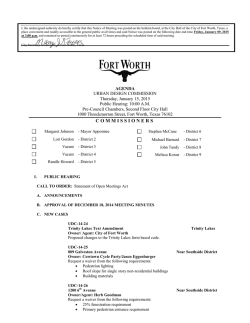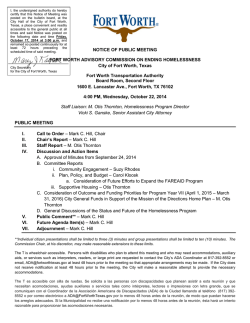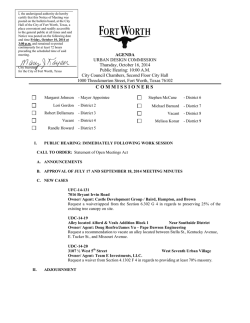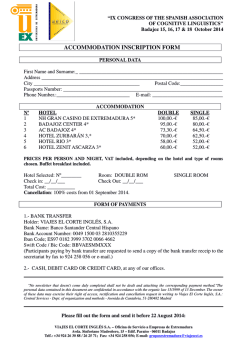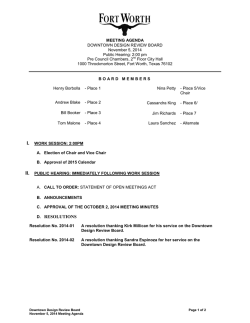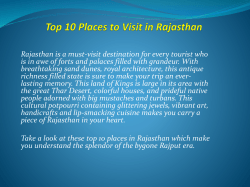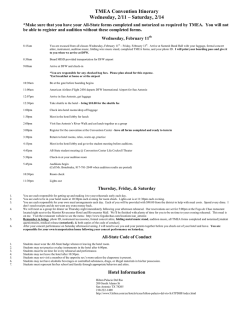
Download/Print Full Itinerary February 2015 (PDF)
38 Villa Avenue, San Rafael, CA 94901 Phone: 415-381-5861 ◆ 888-367-6147 [email protected] ◆ www.originalworld.com CST Permit #2057026-40 Rural Rajasthan and Tribal Gujarat With Naguar Cattle Fair and Baneshwar Festival January 23-February 14, 2015 After you have seen the Taj and visited the “Golden Triangle;” after the forts and castles of the glorious Maharaja period; maybe even after you have visited beautiful South India -‐ return to India to see the traditional rural lifestyles of the people. This tour ventures away from the chaos and congestion that India’s cities are known for and we step into the vast heartland of the fascinating states of Rajasthan and Gujarat. On this tour we attend the Baneshwar Festival, a predominantly tribal fair, just outside Dungarpur at the far south end of the state of Rajasthan. We shall stay in wonderful restored heritage properties with character and charm. Many are hosted by descendants of the royal families. There will be ample opportunities to interact with the local people. Jan 23 Day 1: Delhi Arrive Delhi, meet & transfer to hotel near airport at Ashok Country Resort. Jan 24 Day 2: Delhi – Alwar (160 km/3.5 hrs) Hilltop Kesroli Fort / (B,L,D) Enjoy a leisurely morning to relax after the long flight. We start our journey into Rajasthan with a drive to Alwar. Nestled in the Aravalli Hills, Alwar is one of the oldest cities in Rajasthan. Viratnagar and areas around Alwar have footprints of Stone Age men who lived in caves and drew sketches of animals on the walls. These prehistoric sites are an archaeologist's dream. On arrival, we check into hotel Kesroli Fort. The 14th century Hill-‐Fort, Kesroli is the oldest heritage site in India where you can stay. Situated atop the rare, dark Hornstone Breccia rocks, it commands splendid agrarian views from its ramparts which rise to 50-‐65 meters/ 150-‐200 feet. The origins of the seven-‐turreted Hill-‐Fort Kesroli are traced back to over six centuries. It is reputed to have been built by the Yaduvanshi Rajputs, descendants of Lord Krishna, who converted to Islam in the mid-‐14th century to be called Khanzadas. It subsequently changed hands, being conquered by the Mughals and the Jats before reverting to the Rajputs in 1775 when the princely state of Alwar was founded. It saw its golden period under the Ranawat Thakur Bhawani Singh (1882-‐1934), renowned for his equestrian skills. Kesroli makes an ideal base to visit the neighboring palaces, museums and sanctuaries of Alwar. After lunch, we’ll visit Bala Quila and Moosi Maharani ki Chhatri in Alwar. Bala Quila meaning the ‘young fort’, also known as the Alwar Fort, is a large fort, over a hill top. From the city centre, the fort is located at a distance of 595 m and is clearly visible from the city. The extension of the fort from north to south and from east to west is 5 km and 2 km, respectively. Bala Quila consists of 15 large towers and 51 small towers. There are 446 holes for firing guns. Apart from the large masonry works, the fort has many other structures inside it such as the Nikumbha Mahal Palace, which is built of Bengal caned marble pillars and balconies with lattice designs. Moosi Maharani ki Chhatri is the royal cenotaph of Maharaja Bakhtawar Singh and his Queen Rani Moosi. This striking monument is placed out side the main palace building. Based on a pillared sand stone, this double storied structure was built by Vinay Singh, which presents an eye-‐catching spectacle to the viewer with its elephant structural design. Jan 25 Day 3: Alwar -‐ Nawalgarh (Shekhawati) -‐ Mandawa (165 km)/4 hrs / Castle Mandawa / (B,L,D) In the morning after breakfast we leave for Mandawa. Shekhawati is a semi-‐desert region in north Rajasthan located in the triangle between Delhi-‐Bikaner-‐Jaipur. It takes its name after its ruler Rao Shekha. Shekhawati means the garden of Shekha. The towns of Shekhawati are known for their amazing painted havelis in rich artistic tradition and is dubbed the "open-‐air art gallery of Rajasthan.” Most of the buildings are dated from the 18th century to early 20th century. The Shekhawati landscape is dotted with so many havelis that tracking them is something like a treasure hunt. Various forms of fine art adorn the walls and the ceilings of these structures, complimenting the otherwise flat and barren land. The havelis are noted for their frescos depicting mythological themes and that of huge animals. Some later-‐day frescos show the arrival of the British and highlight steam locomotives and trains, probably for the benefit of those members of the household who did not want to travel to distance places by train or see this newly introduced mode of transport. Nawalgarh, founded in the 18th century by Nawal Singh, has some of the finest frescos in the Shekhawati region. A huge fort with a colorful bazaar and numerous havelis with elaborate architecture makes it an interesting destination. We will visit some of the prominent havelis such as Anandilal Poddar Haveli, Aath Haveli and Hodh Raj Patodia Haveli. We’ll arrive in Mandawa and check into the Mandawa Castle, now a heritage hotel. After lunch, we explore Mandawa visiting the famous "The Open Air Art Gallery of Rajasthan" known for the plethora of plain red havelis, and this rich artistic region known as Shekhawati. The havelis, painted predominantly in blue, maroon, yellow green and indigo have beautiful wall paintings that adorn there walls. Castle Mandawa was founded in the mid-‐18th century. The imposing mirage-‐like fort, now a heritage hotel, is maintained in classic medieval themes with modern facilities. The archway is painted with interesting forms of paintings of Lord Krishna and his cow herds. The sprawling architecture houses a different theme in different wings. The spacious rooms are adorned by intricate interior wall paintings and mirror work with an open terrace that offers a panoramic view of the whole town. The women folk of the Mandawa family, who lived in a royal style, once used this floor. The ambiences of those years still linger around the rooms. The Mandawa family has a unique collection of their preserved paintings and antiques that adorn the main huge hall in the center of the castle, originally the durbar hall and now an exotic lounge. The ceremonial costumes of the family collection and the precious arms with handles of jade and beautiful curios brought by the British as a gift for the nobles are well placed like the showcase of a museum. The hotel is well equipped with modern facilities in an ethnic set-‐up. A stay here is an experience in itself with thematic evenings and medieval cuisine. Jan 26 Day 4: Mandawa – Nagaur -‐ Naguar Cattle Fair (190 km/4-‐5 hrs)/Hotel Royal Jodhpur Camp / (B,L,D) After breakfast we depart for Naguar, a quaint Rajput town located in northeastern part of Rajasthan. On arrival, we check-in at the hotel, have some lunch and then attend the Naguar Fair. The Nagaur Fair or the Cattle Fair of Rajasthan is the second largest cattle fair of India, and boasts of trading about 70,000 bullocks, camels and horses every year. Thousands of animals, magnificently garlanded with accessories to provide a vibrant look to them, are gathered at the fair for trading. The owners, displaying their colorful turban and long moustaches, sell cows, bullocks, oxen, horses and camels. In addition to the huge animal exhibition, the fair is popular for its Mirchi Bazaar (red chilly market), which is the biggest in India. The fair also trades for wooden items, iron-crafts and camel leather accessories and many other things. Besides observing the locals doing business, visitors get excellent opportunity to enjoy a diversity of activities at the fair. The major sports held at the fair include tug-of-war, camel races, bullock races and cockfights. Jugglers, puppeteers, storytellers and campfire evenings make it an authentic slice-of-life experience for the traveler. We shall enjoy the stillness of the desert sand amid the enchanting ambience created by the folk music of Jodhpur. Our Accommodation: The Royal Camp at Nagaur is pitched on an old polo ground within the historic walls of the Ahichattragarh Fort, a spectacular Rajput-‐Mughal bastion that dates as far back as the 5th Century. The tents are stylish and luxurious, with attached baths, hot water shower and the surroundings; a unique complex of magnificent palaces, airy pavilions and intricate waterways; truly magical. Jan 27 Day 5: Naguar – Pushkar-‐ Kishangarh (170 km/ 4 hrs )/ Phool Mahal / (B,L,D) Another glorious day driving through rural Rajasthan! After driving three hours, we shall stop in Pushkar for a brief stroll and you can have refreshments at the Pushkar Palace Hotel on the lake (pay directly). Another one hour drive brings us to Kishangarh, a sleepy town about 27 km from Ajmer, founded by Kishan Singh, a Rathore prince in the first quarter of the seventeenth century. Kishangarh is a treasure trove of art and handicrafts. The town claims one of India’s foremost schools of miniature paintings, founded in the 18th century. One of the most famous paintings representative of this school is that of Radha, Krishna’s consort who is portrayed as an exceptionally beautiful woman with enamoring almond eyes. The Bani Thani style of miniature painting in Kishangarh went through a spurt of excellence under Nihal Chand -‐ painter in court of Raja Sawant Singh. At present Kishangarh is renowned for its wholesale market of red chilies, marble and granite cutting industry and a cotton weaving center. The handicraft of Kishangarh has earned a name for itself in the world market. On arrival, check into hotel and enjoy lunch at the hotel restaurant. This afternoon we shall visit Roopangarh Fort, which houses a good number of exquisite miniature paintings with the deities and the religious epics as their subjects. A pointed arched gateway adorned with painted elephants and guards, offers entry into the fort. Our accommodation, the Phool Mahal, was constructed in 1870. Surrounded by landscaped gardens and located in close proximity to the Kishangarh Fort, it offers grand views of the Kishangarh Fort and Gundalo Lake. Jan 28 Day 6: Kishangarh -‐ Bundi (172 km/4 hrs) /Hadoti Palace / (B,L,D) This morning we drive to Bundi, an oasis in the desert state, a serene civilization far from the maddening crowds and chaos. In ancient times, the area around Bundi was apparently inhabited by various local tribes, of which the Parihar Meenas were prominent. Bundi and the eponymous princely state are said to derive their names from a former Meena king called Bunda Meena. Bundi was previously called “Bunda-‐Ka-‐Nal", Nal meaning “narrow ways”. Later the region was governed by Rao Deva Hada, who took over Bundi from Jaita Meena in 1342, renaming the surrounding area Haravati or Haroti. A substantial wall with four gateways encircles the city. Bundi is one of the few places in India that can lay its claim to an authentic school of painting, "The Bundi School." The splendid paintings in the Chitrashala in the Bundi Fort are par excellence and can be compared with probably the best anywhere in the world. Afternoon tour includes: Sukh Mahals evokes memories of Rudyard Kipling who not only stayed here but found inspiration for his famous work KIM. Sar Bagh has 66 royal cenotaphs. Step wells (Bawari) are another prominent highlights of Bundi, these served as water reservoirs in the months of summers (drinking and washing). There were originally 50, now 32 remaining; built by Mother Queen of Bundi in 1699 and were donated for public welfare. The most beautiful step well is Rani Jiki Barol, which we will visit. It's a fine example of Hindu and Jain architecture. Taragarh Fort was built in 1345 and is great to ramble around at your leisure. The fort is reached by a steep road leading up the hillside to its enormous gateway. This fort counts amongst the most famous ones in Rajasthan for its intricate structures and a highly-‐regarded painting gallery (from here originated the Bundi style of mural painting). The view over the town and surrounding countryside from the top are magical, especially at sun set. Inside the ramparts are huge reservoirs carved out of solid rock, and the Bhim Burj, the largest of the battlefields, on which there is a mounted cannon. The Chhatar Mahal is adorned with beautiful wall paintings of the famous Bundi School. And so are the Zanana Mahal (palace for the queens) and Badal Mahal. Jan 29 Day 7: Bundi -‐ Bijapur (110 km/2.5 hrs) / Castle Bijapur / (B,L,D) After breakfast we drive to Bijapur. We shall stop to visit Bassi village, known for its marvelous historical forts, temples and 'Kurds' as well as for its sculptures and woodcraft.. On arrival, we check in to the hotel and have lunch. This afternoon, we visit Bundi Palace and Chittashala Gallery that exhibits great Indian miniature paintings; and explore nearby villages. Jan 30 Day 8: Bijapur -‐ Narlai (250 km/5-‐6 hrs) / Rawla Narlai / (B,L,D) We’ll depart after breakfast and drive four hours to the extraordinary Ranakpur Jain Temple Complex., surrounded by tangled forests with monkeys abounding in the courtyard, Ranakpur is one of five important pilgrim centers for the Jain community. Noted for its grandiose scale and elaborate ornamentation, of the three temples, the Adinatha is the most outstanding. Built by Daranshah in 1439, the temple is dedicated to the first Jain Tirthankara saint. The whole, including the extraordinary array of 1144 sculptured pillars each distinct in design, carved ceilings, and arches decorated with friezes depicting scenes from the lives of the Jain saints, Jain mythology and cosmology; is fascinating. This is a living place of worship so we most likely will see people mediating, chanting or performing rituals. After the visit, we stop for lunch at Maharani Bagh (Mango Orchard of the Maharaja of Jodhpur) near the temples. We continue driving 1.5 hours to Narlai -‐ a royal hunting retreat, between Jodhpur and Udaipur is an enchanting new destination. Our accommodation, The Rawla, lies at a foothill of a stupendous 350 -‐ foot single rock granite hill amidst dramatic boulders and ancient temples. Maharaj and Rani Swaroop Singh and their sons oversaw the careful restoration of this 15th century home of Marwar nobility. The ambience is a special blend of aesthetics and comfort that envelope the senses. Jan 31 Day 9: Narlai / Rawla Narlai / (B,L,D) Full day explore the surrounding region including bustling bazaars and temples where a miraculous flame has burnt for centuries producing saffron instead of soot! Wishes made here, it is said, come true. Feb 1 Day 10: Drive Narlai – Dungarpur (180 km/4 hrs) Udaibilas Palace/ (B,L,D) We shall depart the hotel at 9 am for the drive to Dungapur, a picturesque town in the far south end of Rajasthan, inhabited by the Bheel tribe. One can get an insight into the life of the local people of Dungarpur while visiting. Dungarpur, situated in the foothills of the Aravalli hills, was founded in 1282AD by Rawal Veer Singh Dev. At the time of inception Dungarpur was popularly known as 'Dungar na Gharan', because in local Vagdi language 'dungra' means small hills. In 1358AD Rawal Dungrsinah renamed 'Dungar na Gharan' to Dungarpur. The city of Dungarpur is well known for its distinguished style of architecture that has been extensively followed in the royal palaces and havelis (mansions). These royal residences are adorned by 'jharokhas' built in stone in a unique style typical of the area developed during the reign of Maharawal Shiv Singh (1730-‐1785 A. D.) The district gold and silversmiths are renowned for lacquer painted toys and picture framing. High quality Green marble and soapstone excavated from Dungarpur district is exported across the globe. On arrival, lunch and an afternoon tour of the town including: The Old Fort of Dungarpur is the major landmark of Rajasthan and renders the spectacular view of the town of Dungarpur Juna Mahal is a seven storied structure, resembling a fortress with crenellated walls, turrets, narrow entrances and corridors. The interiors are embellished with beautiful frescoes, miniature paintings, glass and mirror work. Our Accommodation: The history of Udai Bilas Palace dates from the mid-‐19th century, when Maharawal Udai Singhji-‐II, a great patron of art and architecture, built a wing of bluish grey local stone “Pareva” overlooking the lake and the “Ek Thambia Mahal”, featuring intricate sculptured pillars and panels, ornate balconies, balustrades, bracketed windows, arches and frieze of marble carvings, a veritable marvel of Rajput architecture. Nestled in idyllic splendour, with the blue waters of Gaibsagar lake on one side and a cove of private reserve forest on the other, Udai Bilas Palace is the embodiment of the old world charm of princely India. Still under the control of the royal family of Dungarpur and remaining a royal residence, Udai Bilas Palace has been now converted into a heritage hotel (lucky for us!) Feb 2 Day 11: Dungarpur – Baneshwar Festival / Udaibilas Palace / (B,L,D) We spend a full day soaking up the excitement at the annual Baneshwar Festival, a predominantly tribal fair with more than half of the congregation consisting of Bhils. We shall pack a lunch prepared by our hotel. We drive 50 km (approx 1.5 hours) to get out to the fair site in Baneshwar held at a small delta formed by the Rivers Som and Mahi, from Magh Shukla Ekadashi to Magh Shukla Poornima during Shivratri. This is a religious festival with simple and traditional rituals. On this occasion the tribal folks from the neighboring states of Madhya Pradesh and Gujarat join their brethren from Rajasthan to offer prayers to Lord Shiva. Rituals of the Baneshwar Fair in Rajasthan, India On Magh Shukla Ekadashi, the priest -‐ called the Mathadhish, arrives at the fair site from Sabla, in a huge procession. A 16 cm silver image of Mavji on horseback is also brought here. The river water supposedly becomes holier when the Mathadhish takes a bath. Hence, people bathe along with him in the river. The Bhils consign the ashes of their dead at the confluence of the rivers. The temple of Baneshwar Mahadev remains open from 5.00 a.m. to 11.00 p.m. during the fair. In the morning, saffron is applied to the Shivlinga after it is bathed and an 'aarti' of burning incense is waved before it. In the evening, 'bhabhut' (ash) is applied to the Linga and an 'aarti' with a fine-‐wick lamp is waved. Devotees offer wheat flour, pulses, rice, jaggery, ghee, salt, chillies, coconut and cash. Prayers are offered five times a day in the temples of Lakshmi -‐Narayan and Brahma. Brass gongs are struck at the time of 'aarti'. During the fair, 'aarti' of Mathadhish is also performed and Raslila takes place at night in the Lakshmi Narayan Temple. Offerings, similar to those at the Baneshwar Temple, are made at these shrines too. The Bhils attending Baneshwar Fair of Rajasthan sing traditional folk songs in high pitched voices sitting around a bonfire every night. Cultural shows are arranged by youngsters of the clan. Groups of villagers are also invited to participate in the program. The fair resounds with the gaiety of songs, folk dances, magic shows, animal shows and acrobatic feats. Feb 3 Day 12: Dungarpur – Jambughoda (260 km/6-‐7 hrs) / Jambughoda Palace Hotel / (B,L,D) Today we set out to the Jambughoda Palace, a simple royal mansion in the midst of mature gardens -‐ a beautiful retreat for nature lovers. We will pass through small towns and villages, stopping for tea and snacks in Godhra. Feb 4 Day 13: Jambughoda –Excursions to Tribal Villages / Jambughoda Palace, heritage/ (B,L,D) We shall engage with the local people today on a full day excursion to the tribal villages of Jambughoda. Most of the indigenous people living in and around Jambughoda are ‘Rathwas’ & ‘Nayaks’. They are superstitious and God-‐fearing people. The entrance to their home is through a richly carved wooden door with figurines and tribal icons. The front is usually decorated with Pithora paintings for which the ‘Rathwas are known for. Their dwellings are separated from each other by considerable distance, rather than living in a community close together. The tribal museum of Chhota Udaipur has a large collection of tribal artifacts. Many tribal artifacts are also brought for sale in the ‘haats’ (weekly markets) in the city and nearby villages. Feb 5 Day 14: Jambughoda – Ahmedabad (140 km/3.5 hrs) / Lemon Tree or Four Points Sheratan / (B,L,D) Today’s drive to Ahemdabad is on a decent road and short by India travel distances! We stop enroute to visit the World Heritage Site of Champaner (the site of Pavagarh Archeological Park) to see the vast complex of mosques built by Mahmud Begada. We shall stop for lunch at a traditional restaurant and check in at the hotel. Free time to relax and freshen up before dinner. This evening we enjoy a traditional Gujrati vegetarian dinner with local dance and music at Vishala, an authentically created Gujrati crafts village complete with traditionally decorated mud huts where potters and weavers are at work. Here we visit the Vechaar Utensils Museum with its collection of 2500 Gujrati utensils. Feb 6 Day 15: Ahmedabad-‐ Sayla (135 km/3 hrs) / Old Bell House Heritage Home Stay (B,L,D) Today we venture out of the city to the village of Sayla where mirrors are made for Gujarat's famous mirror work embroidery. We shall visit the Bharwad and Kathi villages where beadwork traditions thrive, the silk weavers who use the ikat technique, and the town of Wadhwan where women work on bandhani or tie-‐and-‐dye. Wadhwan's walled town has historic buildings and a living heritage of metalwork crafts. The state of Sayla was founded in 1751 by Seshmalji, who is said to have fought many battles and to have captured Sayla from the Kathi Darbars and made it the capital of his state. He is credited with building the fortified wall around Sayla and founding the Darbargadh or Rajmahal (palace), which is still the residence of the Jhala family. The palace has halls for audiences, administrative and judicial meetings of the rulers, life-‐size portraits of successive rulers and attractive carvings. Among the progressive rulers of Sayla was Thakur Saheb Vakhat Sinhji who set up rural industries and a thermal power house in the 19th century. Our Accommodation: The Old Bell Guest House, said to be the British residency and European guesthouse of the princely state, has been renovated and restored by the ruling family of Sayla. The charming and homey hotel offers accommodations in 10 a/c double bedrooms with attached baths featuring hot-‐and-‐cold showers and western toilet fixtures. Each of the rooms has a TV, a telephone and other modern conveniences. The galleries are lined with historic photographs of Sayla. Feb 7 Day 16 Sayla-‐Ahmedabad (135 km/3 hrs) / Lemon Tree or Four Points Sheratan / (B,L,D) This morning we depart at 7 am after an early breakfast and go directly to visit the wonderful and fascinating Calico Museum of Textiles. Visiting hours are 1030-‐1230 am. Note: we must inform you that visiting the museum is pending availability; it is private museum and restricted to a very limited number of entrances per day and they do not allow advanced booking, though we always managed to get in. Do bring your own water inside, it is stuffy and there are no vendors inside. The museum exhibits spectacular antique and modern textiles including rare tapestries, wall hangings and costumes from all the regions of Gujarat as well as the rest of India. See a variety of textiles ranging from incredibly long, colorful embroidered wall hangings to Zari saries embroidered in gold and weighing 9kg. Also on display are old weaving machines. After visiting the museum, we shall have lunch at a local restaurant. This afternoon we visit the Sabarmati Ashram, situated on the western bank of the Sabarmati River. This ashram, founded in 1918 by Mahatma Gandhi, who revitalized the textile industry here, became the headquarters during the struggle for Indian Independence and it is befitting that it is now primarily a spinning wheel factory. Evening at leisure. Feb 8 Day 17 Ahmedabad / Lemon Tree or Four Points Sheratan / (B, D) This morning we shall participate in the Heritage walk of Ahmedabad, 8 am-‐10 am, conducted by the Ahmedabad Municipal Corporation with CRUTA Foundation. There is also a half hour special slide show running through the city's history from a 10th century AD ancient site known as Ashaval to the present walled city re-‐founded during the period of Ahmedshah and onwards. A special feature of Ahmedabad is the plan of the old city, comprising numerous pols, self contained neighborhoods, sheltering large numbers of people, traversed by narrow streets, usually terminating in squares with community wells and chabutaras for feeding birds. The walk begins from the picturesque Swaminarayan Mandir in Kalupur and ends in the most glorious architectural legacy, the Jumma Masjid. In between there are numerous pols, havelis, ornamental facades, workplaces of artisans and number of magnificent Hindu and Jain temples. The walk is guided by volunteer Rajesh Gajjar, proceeding from Kavi Dalpatram Chowk -‐ which housed the great 19th century Gujarati poet in Lambeshwar ni Pole, to the classic reminisces of the city's textile era -‐ the Calico Dome, to the century old Kala Ramji Mandir in the Haja Patel ni Pole with a unique idol of Lord Rama in dark color and in a sitting posture. The walk moves through Doshiwada ni Pol, Zaveri Vad to Chaumukhji ni Pol as you view ornate temples with their fascinating wooden carvings hidden under plain exteriors camouflaged beneath the aura of Mughal rule and lanes punctuated with intriguing chabutras (bird feeders) to a three foot wide alley leading into the 110-‐ year old Harkunvar Shethani ni Haveli. Moving through the historical Fernandez Bridge brings you to Manek Chowk where amidst the deafening traffic and full of parked vehicles Rajesh tells of the legend of Manek Baba after whom the chowk was named and the Manek Baba Mandir at the site where he shrank and entered a bottle to show his magical powers to Ahmed Shah, the founder of the City. The walk continues into the Rani no Hajiro through the Badshah no hajiro and finally culminates at the magnanimous Jama Masjid. Return to the hotel for lunch (pay direct) and a bit of rest. This afternoon we visit the Adalaj Step Well, built in 1499 by Queen Rudabai, wife of the Vaghela chief, Veersinh, this five-‐story step well was not just a cultural and utilitarian space, but also a spiritual refuge. It is believed that villagers would come everyday in the morning to fill water, offer prayers to the deities carved into the walls and interact with each other in the cool shade of the well. Afterwards some independent time to browse the textile shops if you so desire. Feb 9 Day 18 Drive Ahemdabad – Poshina (180 km/5 hrs) / Hotel Darbargadh Poshina / (B,L,D) We’ll depart after breakfast for our drive to the Posina, a beautiful place surrounded by Garasia and Bhil villages. On arrival, we’ll enjoy home-‐cooked family lunch. This afternoon we visit Poshina Village. We will observe a demonstration of the making of the sacred horses in terracotta, clay utensils, jewelry and tribal knives. You will also see colorful walls painted with camels and elephants. Of course we shall visit the village Hindu temple dedicated to Shiva Nilkanth Mahadev. Often the ebst part of temple visits is just observing people in their acts of devotion and reverence. This evening at leisure to enjoy the property and/or engage in conversation with the hosts. Our Accommodation: Darbargadh Poshina -‐ A Heritage Home set in the tribal lands of the Arravallis. The owners of this ancestral fort invite you to explore the Adivasi and Garasia tribal culture of North Gujarat and South Rajasthan, enjoy fresh home cooked meals, featuring recipes passed on from generation to generation, and indulge in the hospitality of a family that ruled Poshina for eight generations before independence. Feb 10 Day 19: Poshina – Darbargadh -‐ Poshina / Hotel Darbargadh Poshina /(B,L,D) Today’s excursion by jeep offers fascinating glimpses into rural Indian life. The drive through the picturesque countryside will include visits to the remote villages of the ‘Adivasi’ and ‘Garasia’ tribals who will also give you archery demonstrations and pastoral people like the ‘Rabaris’ who keep camels, sheep and goat. We begin with a walk through Poshina village. Imagine a market bustling with activity where you can watch colorful women from the tribal hamlets and tribal men unloading their produce. You will be able to observe craftsmen at work-‐forging swords, daggers, bows and arrows, potters making terra cotta horses and other figurines, besides clay utensils, jewelers sell chunky ornaments to the residents. The Jain temples built in 1214 A.D and the ancient richly carved Shiva temple are also a wonderful visit. Next, we travel to Chatrang and Bedi Villages of Gowala and Garacia tribes. You will also visit the Kumbharia Jain temple, pottery & terracotta horse village of Saleka and few tribal temples. Feb 11 Day 20 Poshina -‐ Patan-‐ Modhera – Bajana (Little Rann of Kutch) (210/5 hrs) / Royal Safari Camp / (B,L,D) We depart by 8 am this morning for the drive to Patan to visit some of its 100 Jain Temples and Rani Kava Steps (ancient step well). A short 10 km further, we visit the exquisite Sun Temple in Modhera, situated on the banks of the Pushpavati River. Here you will see women of all ages from very young girls to elderly, dressed in bright yellows, orange and reds representing and honoring the sun. Next stop is to visit the Salvi family, master weavers of the colorful Potala silk including the ancient art of double ikat. This is quite a special treat! We continue to Bajana Village. The area is surrounded by tribal villages, making the stay here fascinating and especially exciting for photographers. The area is also known as Dasada. It is famous as the world's last refuge of the Indian Wild Ass (Khur) for the conservation of which it has been declared as the Indian Wild Ass Sanctuary. Capable of reaching high speeds when galloping across the Rann, the wild ass is usually seen in small herds. It is also home to various unique mammals apart from wild Ass such the Indian Wolf (Canis indica), Desert Fox (Vulpes vulpes pusilla) and Nilgai (Boselaphus tragocamelus). Late afternoon/early evening we will have an excursion to see the nearby villages, observe lifestyles. You may also see some wildlife. Overnight at Royal Safari Camp (cottages, western toilets, running hot/cold water). A fantastic mix of rustic comfort in a rural setting in Bajana Village. Feb 12 Day 21 Drive Bajana -‐ Bhujodi – Hodka Village (280 km/6 hrs) / Sham-‐e-‐Sarhad Resort in Hodka Village/ (B,L,D) We’ll depart the resort early for safari to view wildlife including the wild ass. Return to resort for an early lunch and continue to Hodkha Village. NOTE: Bring a wad of toilet paper for the drive today. There are very clean roadside toilets, traditional style. On the way we’ll visit Dhamaeka, the block printing village and Bhujodi Village to meet the nomadic Rabari who weave camel wool on pit looms into blankets and shawls. Time permitting, we also visit Chandaben Shroff's project. The Shrujan organization, which started as a small family project, now has a network of over 2500 craftswomen spread across 85 villages. Currently, Shrujan works with 16 different styles of embroidery, done by a variety of communities and tribal groups. Their excellent exhibit displays the various embroidery styles. Feb 13 Day 22 Hodka Village / Sham-‐e-‐Sarhad Resort in Hodka Village / (B,L,D) A full day to visit various fascinating tribal villages surrounding Bhuj. Each tribe can be identified by its traditional attire and specializes in a different form of handicraft. Among others, you shall visit Banni settlements to see the traditional handicrafts of these Abyssinian settlers, who migrated to India from Abyssinia around the 10th Century. Their work is the famous glass embroidery. (Special Permission is to be obtained from the police /collector’s office). The Banni tribal dwellings are made of round mud huts called `bhungas‚ with a single central support pole and a thatched or tiled roof, all surrounding a large community courtyard. The women tend to be shy with male visitors, but are hospitable and will welcome you into their homes. They have an exquisite personal collection of embroidered quilts and garments. Walls, shelves, grain containers and cupboards are fashioned in mud with decorative designs washed with lime paste and embedded with mirrors that throw hundreds of shimmering reflections. You will also see a variety of handicrafts, including textiles, vegetable color dye printing, Rogan art (wax printing), glass beadwork, woolen shawls, leather articles and more. We visit Kala Raksha Trust in Sumrasar Sheikh village, a grassroots social enterprise, dedicated to preservation of traditional arts. Kala Raksha produces some of the most exquisitely hand embroidered and patch-‐worked products made in Kutch. Also visit their museum and Kala Raksha Vidyalaya (Institue of Design). We then visit some local weaving families in Sumarsar village, famous for Scoof Embroidery, Nirona Village with its fabulous Rogan art (wax printing) & bell making and Ludiya (aka Ghandi Gram) village. Return to Hodka Village for overnight. Feb 14 Day 23 Fly to Bombay-‐Depart (B) This morning we drive 1.5 hours to the town of Bhuj. We’ll visit the Kutch Museum and Prag Mahal followed by a walk in the old city. We’ll enjoy our last Indian meal, a traditional Gujarat Thali lunch (all vegetarian) at the Hotel Prince restaurant. After lunch there will be a short visit to the house of Mr. Alli Mohamad Isha, a tie and dye specialist, for an interactive workshop on the art. Afterwards we transfer to the airport for the flight to Mumbai, 9w340 dep 515 pm, arriving 635 pm. Transfer to hotel by airport. Rooms available for wash/change. Transfer to intl airport for flt home. NOTES: The amount of time it takes to cover the distances lusted each day is an estimate and does not include time for visits enroute, lunch and refreshment breaks. Generally, we depart after breakfast and arrive at our final destination for the night in late afternoon or early evening before dinner time. PRICES Based on min 6 people: $4675 per person, single room supplement: $1300 Plus Airfares: (estimate/exact prices when booked): Bhuj-‐Bombay $130 Includes: Accommodation with meals as indicated 1 night Delhi at Holiday Inn(B) 1 night Alwar at Hilltop Kesroli Fort (B,L,D) 1 night Mandawa at Castle Mandawa (B,L,D) 1 night Naguar at Royal Jodhpur Camp (B,L,D) 1 night Kishangarh at Phool Mahal (B,L,D) 1 night Bundi at Hadoti Palace (B,L,D) 1 night Bijapur at Castle Bijapur (B,L,D) 2 nights Narlai at Rawla Narlai (B,L,D) 2 nights Dungarpur at Udaibilas Palace (B,L,D) 2 nights Jambughoda at Heritage Home Stay (B,L,D) 3 nights Ahmedabad at Lemon Tree. Or Four Points Sheraton 4* (B, 2 L,D)* 1 night Sayla at Old Bell House (B,L,D) 2 night Poshina at Darbargadh Palace (B,L,D) 1 night Bajana at Royal Safai Camp (B,L,D) 2 nights Hodka Village at Sham-‐e-‐Sarhad (B,L,D) Room for wash & change in Bombay at Kohinoor Continental until 10 pm *At Lemon Tree in Ahmedabad, the deluxe rooms have river views but only one queen or king bed. The premier rooms are larger, offer twin beds. Some have river views, but we cannot guarantee river view. Transport in A/C Toyota Tempo Traveler as per itinerary All arrival / departure transfers as per Itinerary Professional accompanying guide throughout: 2 separate guides, one for Rajasthan and the other for Gujarat Entrance to Monuments/Museum Still Camera Fees Porters at hotels and airports Bottled water in the vehicle (2 liter bottles per day per person) India Gov Service Tax 3.09%. Does Not Include: International flight, insurance, visa fee, video camera fees, tips, expenditure of personal nature such as laundry, telephone calls, drinks
© Copyright 2025
